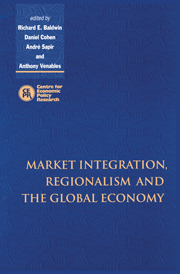Book contents
- Frontmatter
- Contents
- List of figures
- List of tables
- Preface
- Acknowledgements
- List of conference participants
- 1 Introduction
- PART ONE REGIONALISM AND THE GLOBAL ECONOMY
- PART TWO MARKET INTEGRATION AND REGIONALISM
- 7 Operationalising the theory of optimum currency areas
- Discussion
- 8 European migrants: an endangered species?
- Discussion
- 9 Geography and specialisation: industrial belts on a circular plain
- Discussion
- 10 Convergence … an overview
- Discussion
- 11 Convergence as distribution dynamics (with or without growth)
- Discussion
- Index
9 - Geography and specialisation: industrial belts on a circular plain
Published online by Cambridge University Press: 24 February 2010
- Frontmatter
- Contents
- List of figures
- List of tables
- Preface
- Acknowledgements
- List of conference participants
- 1 Introduction
- PART ONE REGIONALISM AND THE GLOBAL ECONOMY
- PART TWO MARKET INTEGRATION AND REGIONALISM
- 7 Operationalising the theory of optimum currency areas
- Discussion
- 8 European migrants: an endangered species?
- Discussion
- 9 Geography and specialisation: industrial belts on a circular plain
- Discussion
- 10 Convergence … an overview
- Discussion
- 11 Convergence as distribution dynamics (with or without growth)
- Discussion
- Index
Summary
Introduction
What forces determine the spatial pattern of industrial specialisation? Near the top of an economist's list of answers to this question would probably come differences in technology or endowments. A good deal further down we might find geography – the spatial position of locations – and agglomeration – the desire of firms or other economic agents to locate close to each other. This ranking comes in part from the intellectual tradition of economics. We naturally look to preferences, technology and endowments to determine everything. It also comes from the traditional focus of international economics on trade between countries with dissimilar endowments.
The ‘new economic geography’ literature of the last five years has started to redress the balance. Within deeply integrated regions such as the European Union it seems hard to argue that differences in technologies or in endowments of immobile factors are key determinants of patterns of specialisation and trade. And perhaps this also becoming true at the world level as more activities become tradable, and firms and factors of production become increasingly internationally mobile. We need a theory of the location of activity which is not dependent on assumed differences in locations' factor endowments or technologies, but which can address the pattern of location of economic activity in a world in which (almost) everything is mobile. Geography and agglomeration then come to the fore as possible determinants of the location of activity and the pattern of trade.
The ‘new economic geography’ literature focuses on agglomeration and provides analytical foundations for forces which induce agglomeration.
- Type
- Chapter
- Information
- Market Integration, Regionalism and the Global Economy , pp. 254 - 273Publisher: Cambridge University PressPrint publication year: 1999
- 4
- Cited by

